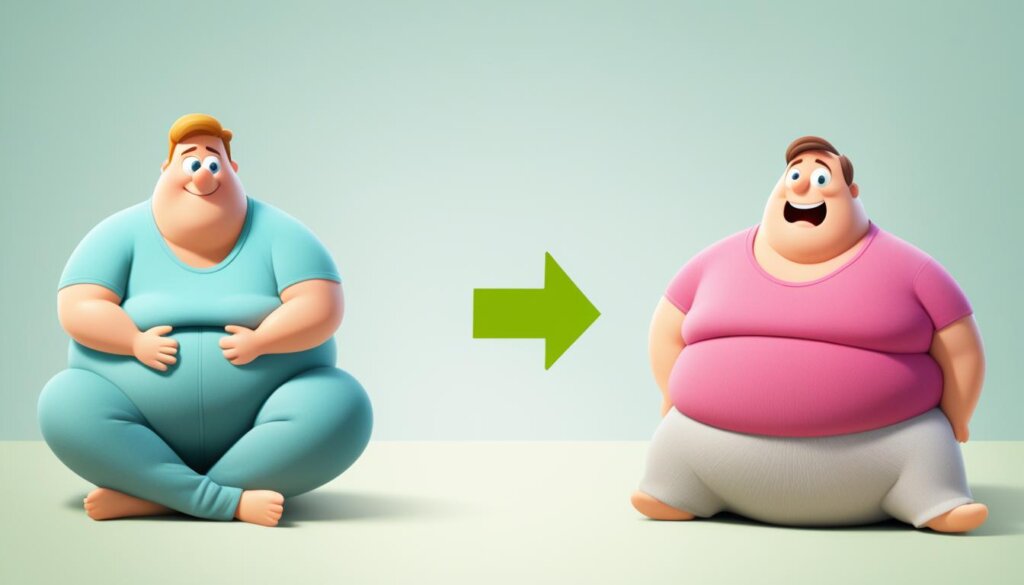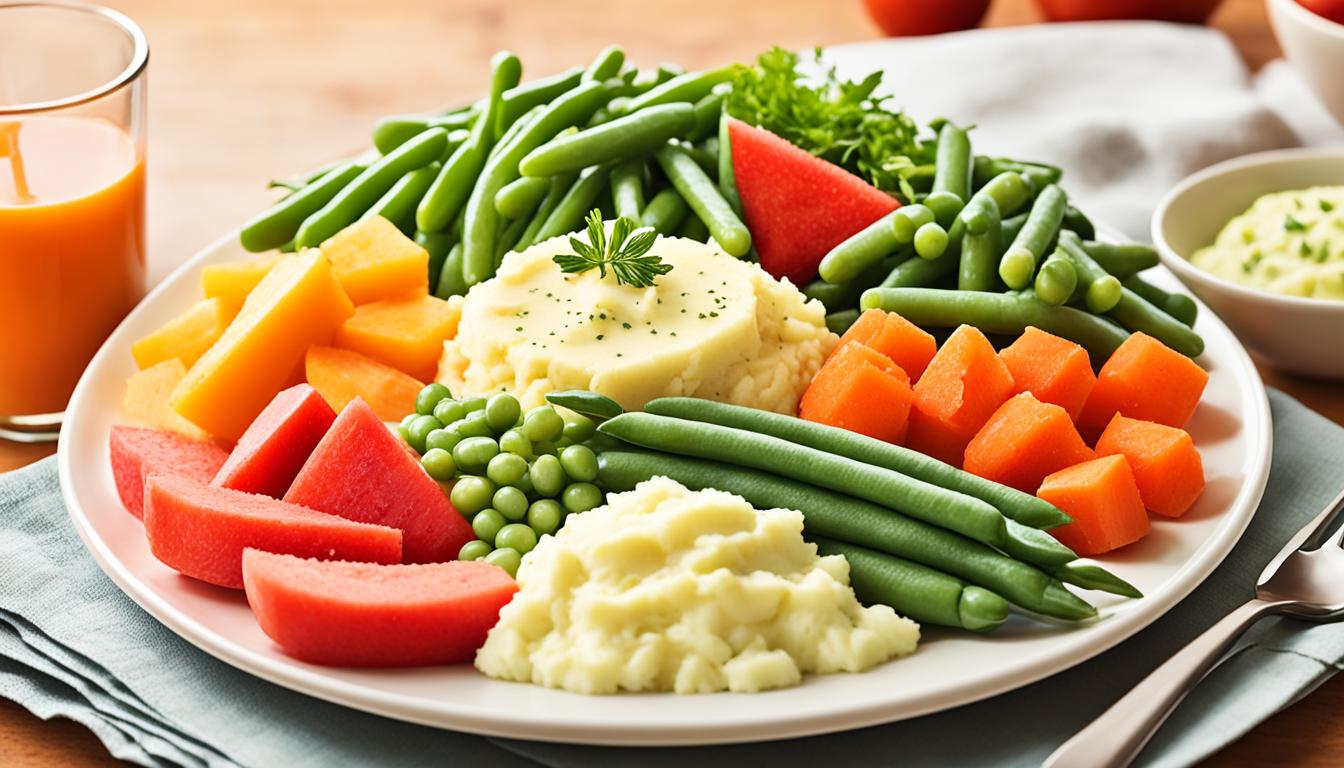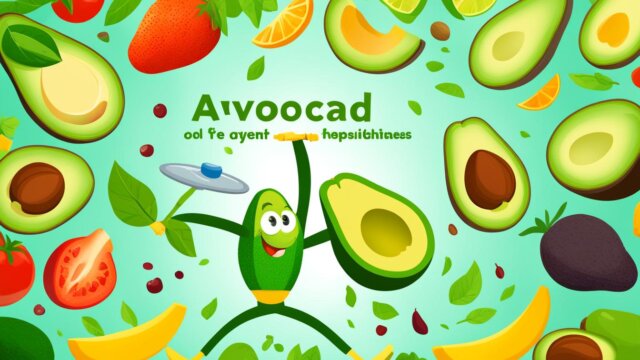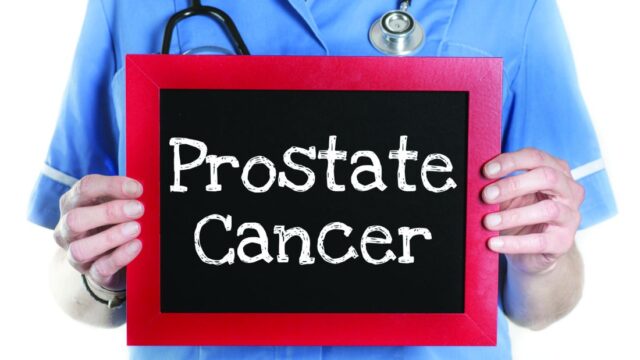FTC disclaimer: This post may contains affiliate links and we will be compensated if you click on a link and make a purchase.
For people with digestive problems or after some medical treatments, eating low-fiber foods can help. In fact, 20% of adults in the U.S. eat low-fiber foods as their doctors suggest. This is to help with issues like narrow bowels, Crohn’s disease, and ulcerative colitis.
A low-fiber diet means you eat fewer high-fiber fruits, veggies, and grains. This can make your bowel movements less frequent and smaller. It can also ease symptoms like diarrhea and belly pain.
But, it’s key to follow a low-fiber diet with a doctor’s advice. It can be hard to get all the nutrients you need. A dietitian can make sure you get what you need while eating low-fiber foods.
Key Takeaways
- A low-fiber diet can provide relief for digestive issues and after certain medical treatments
- It limits high-fiber foods and reduces undigested material in the intestines
- This can lead to fewer and smaller bowel movements, easing symptoms like diarrhea
- A low-fiber diet should be followed under medical supervision to meet nutritional needs
- Consulting a dietitian can help ensure proper nutrition on a low-fiber diet
What is a Low-Fiber Diet?
Definition and Purpose
A low-fiber diet limits how much fiber you eat. Fiber is the part of plants we can’t digest. This diet aims to lessen the amount of undigested material in your large intestine. It helps with symptoms like diarrhea, cramps, and trouble digesting food.
Doctors suggest this diet for issues like narrow bowel, recent surgery, or irritation from cancer treatment. It’s meant to be short-term. The goal is to slowly add more fiber as your digestive system heals.
This diet suggests eating 10 to 15 grams of fiber a day. Foods for this diet should have less than 2 grams of fiber each. It helps with digestion but talk to a doctor to make sure you’re getting what you need.
“Fiber is a substance found in plant-based foods that remains undigested in the small intestine.”
Many adults need fiber for good digestion. But for some, a high-fiber diet can make things worse. A low-fiber diet can help ease these problems. But always talk to a doctor to make sure you’re getting enough nutrients.
Foods to Eat on a Low-Fiber Diet
When you’re on a low-fiber diet, you focus on foods that are easy on your stomach. These foods include refined carbs, dairy, tender meats, fish, and eggs. You can have up to 2 cups of milk and milk products daily. Also, enjoy 6-11 servings of bread, cereals, rice, and pasta.
You can have 2-4 servings of fruits, 2 servings of dairy products, and 3-5 servings of cooked veggies.
Some good foods for your diet are white bread, white rice, white pasta, bananas, melons, canned peaches, and well-cooked, peeled, and seeded fruits and veggies. Always check food labels. Some products like yogurt, cereal, and drinks might have extra fiber you should skip.
Avoid high-fiber foods like whole grains, beans, nuts, seeds, and most raw fruits and veggies. Foods to avoid include whole-grains, fruits with seeds, dried fruits, veggies with seeds, uncooked veggies, deli meats, caffeine, nuts, and fruit juice.
Choosing these low-fiber foods can help make digestion easier and manage stomach issues. It’s key to chew slowly and eat smaller, more frequent meals for better digestion.
Low-Fiber foods for Specific Meals
When you’re on a low-fiber diet, pick foods that are soft and easy to digest. Choosing the right foods for breakfast, lunch, and dinner helps your digestive system rest.
Low-Fiber Breakfast Ideas
For breakfast, think about cornflakes with milk, white toast with peanut butter and jelly, and fruit juice. These foods are gentle on your stomach and give you the nutrients you need for the day.
Low-Fiber Lunch and Dinner Options
For lunch and dinner, try a turkey sandwich on white bread, tomato soup, baked fish with mashed potatoes and cooked carrots, and applesauce. These meals are soft and easy to digest.
Snacks can be yogurt, cheese, and crackers. Make sure all foods are soft and tender. Use cooking methods like simmering, poaching, steaming, and braising.
Meal | Low-Fiber Options |
|---|---|
Breakfast |
|
Lunch |
|
Dinner |
|
Snacks |
|
By picking these low-fiber foods for breakfast, lunch, and dinner, you can make a menu that’s easy on your stomach.
“Proper meal planning is key when following a low-fiber diet. Choosing the right low-fiber foods can make a significant difference in your overall comfort and well-being.”

Benefits and Risks of a Low-Fiber Diet
A low-fiber diet can help your digestive health. It reduces symptoms like diarrhea, cramping, and hard-to-digest food. It gives your digestive system a break to rest and recover.
But, a low-fiber diet can be hard to follow for a long time. Adults need about 38 grams of fiber a day, but a low-fiber diet has only 10 grams. Working with a dietitian is key to getting all the nutrients you need.
Adding 5 grams of fiber to your diet each week can help ease back into fiber safely. Not getting enough nutrients is a risk of a low-fiber diet.
A low-fiber diet should not be long-term without a doctor’s advice. Safe foods include ground meat, eggs, and some fruits and vegetables. Avoid foods like processed meats and nuts on this diet.

Doctors may suggest a low-fiber diet for certain health issues. It’s good to eat foods with less than 2 grams of fiber per serving. Aim for less than 10 grams of fiber a day.
Following a low-fiber diet needs close work with your doctor. It’s good for some health issues, like Crohn’s disease. Always talk to a dietitian to meet your nutritional needs on this diet.
Tips for Following a Low-Fiber Diet
When you’re on a low-fiber diet, always check food labels. Some foods like yogurt, cereal, and drinks might have extra fiber you should skip. Stick to soft, cooked foods like refined breads, pastas, and rice, along with dairy, eggs, and canned fruits and veggies. Avoid high-fiber foods like nuts, seeds, dried fruit, whole grains, beans, and most raw fruits and veggies.
Drinking lots of fluids is key to avoid constipation from a low-fiber diet. Always talk to your doctor or a dietitian to make sure you’re getting what you need on this diet. A low-fiber diet might be needed for some health issues, like narrow bowel from diseases or after surgery.
- Look for foods with no more than 1 to 2 grams of fiber in one serving when on a low-fiber diet.
- Choose foods like tender meat, poultry, eggs, dairy products if tolerated, white rice, and canned or well-cooked vegetables and fruits without seeds.
- Good cooking methods for a low-fiber diet involve simmering, poaching, stewing, steaming, braising, baking, or microwaving foods in a covered dish.
“A low-fiber diet can lead to fewer bowel movements and smaller stools. To avoid constipation, drink plenty of water unless advised otherwise by a healthcare provider.”
A low-fiber diet can ease symptoms like diarrhea or stomach pain. But, it’s key to talk to a dietitian if you’re on this diet for a long time to make sure you’re getting enough nutrients.

A typical low-fiber diet has less than 25 grams of fiber a day. Moderate intake is about 10-15 grams a day. It’s best to follow the low-fiber/low-residue diet for over two weeks. Then, slowly add back in high-fiber and residue foods after your symptoms go away.
Recommended Servings for a Low-Fiber Diet | Quantity |
|---|---|
Breads, Cereals, Rice, and Pasta | 6-11 servings of enriched white bread, rolls, biscuits, muffins, crackers |
Fruits | 2-4 servings of canned fruit, fresh fruit, and strained fruit juice |
Milk and Dairy Products | 2 servings of milk, yogurt, custard, and ice cream |
Vegetables | 3-5 servings of well-cooked and canned vegetables without seeds |
Meats, Poultry, Fish, Beans, Peas, and Eggs | 2-3 servings of tender beef, lamb, ham, veal, poultry, and organ meats |
By following these tips, you can manage a low-fiber diet well. Always work with your healthcare team to find the best plan for you.
When to Follow a Low-Fiber Diet
Doctors might suggest a low-fiber diet for some health reasons, like certain medical issues or before certain procedures. It’s often advised for people with gut problems, like diverticulitis, Crohn’s disease, or inflammatory bowel disease. This diet means eating less than 10-15 grams of fiber a day.
If you have a narrowed bowel from a tumor or inflammation, had bowel surgery, or are getting cancer treatments that upset your stomach, a low-fiber diet can help. It’s also good if you’re getting ready for a colonoscopy, which needs your digestive system to be clear.
The aim of this diet is to ease digestive issues and let your intestines heal. You can eat foods like white bread, white rice, fruits and veggies without skins, dairy, and lean meats. But, it’s meant to be short-term. The plan is to slowly add more fiber-rich foods as your health gets better.
Remember, a low-fiber diet can make you poop less, have smaller stools, and might lead to nutrient shortages if done for too long. Always talk to a doctor or dietitian to make sure you’re getting what you need while on this diet.

Low-Fiber Foods and Cancer Treatment
Some people with cancer may need to eat less fiber during treatment. This can help with digestive problems caused by treatments like radiation therapy. Eating less fiber means less undigested material in the intestines. This can ease symptoms like diarrhea, cramps, and trouble digesting food.
Patients should talk to their healthcare team about a low-fiber diet. They will decide if it’s right and for how long. This diet might be needed for certain conditions or treatments that affect the digestive tract.
Dietary Recommendations for Cancer Patients
When on a low-fiber diet, eat foods that are easy on your stomach. Choose soft, cooked veggies without seeds or skins. Also, go for cooked sweet or white potatoes without skin.
Soft-cooked fruits without seeds or skin, ripe bananas, juices, and small amounts of soft melons are good choices. Avoid high-fiber foods like whole grains and certain veggies. Also, limit foods with a lot of fiber.
Stay away from beans, nuts, peas, lentils, and processed meats. Milk, dairy, breads, and cereals should be in small amounts. Choose low-fiber options like white bread and rice instead.
A low-fiber diet can mean fewer bowel movements and smaller stools. So, drink more fluids to prevent constipation.
Following a low-fiber diet can help manage digestive issues during cancer treatment. But, it’s key to work with healthcare pros to find the right diet plan for you.
Transitioning Back to a High-Fiber Diet
After your digestive system has rested and recovered, it’s time to slowly add more fiber back into your diet. Adding fiber bit by bit can stop constipation and make sure you get what you need. Start with a little more fiber each day and see how you feel. If you don’t have any problems, you can keep adding more fiber.
It’s good to go back to a high-fiber diet because it has many health benefits. Eating more fiber helps you stay regular, lowers cholesterol, and can help you lose weight. Adults should eat 25-38 grams of fiber a day, but many don’t get enough.
When you start eating more fiber, try to eat different kinds of fiber-rich foods. These include:
- Whole grains like brown rice, quinoa, and whole wheat bread
- Fruits and vegetables, including the skin for added fiber
- Legumes, nuts, and seeds
Introduce these high-fiber foods slowly and watch how your body reacts. Getting advice from a nutritionist or dietitian who knows about digestive issues can also help you switch back to a high-fiber diet smoothly.
By adding more fiber-rich foods, you help your digestive health and enjoy the benefits of a high-fiber diet. With care and slow changes, you can get back to a fiber-rich way of eating.
Conclusion
A low-fiber diet can help with digestive issues from some medical conditions or cancer treatments. It limits hard-to-break-down foods. This can ease symptoms like belly pain, cramps, diarrhea, and bleeding. But, there’s not much agreement on diet advice for inflammatory bowel disease patients.
Always get advice from a healthcare provider before starting a low-fiber diet. It’s hard to get all the nutrients you need on this diet. Once your health gets better, slowly add more fiber to your diet. This way, you can ease symptoms and move back to a diet full of fiber.
Deciding on a low-fiber diet should be based on your health needs and your doctor’s advice. Knowing when to use it and how to switch back to a high-fiber diet helps you manage your digestive health.
FAQ
What is the purpose of a low-fiber diet?
A low-fiber diet aims to reduce undigested material in the large intestine. This helps ease symptoms like diarrhea, cramping, and food digestion issues.
What types of foods are recommended on a low-fiber diet?
Foods on a low-fiber diet include refined carbs like white bread and pasta. Also, dairy, tender meats, fish, eggs, and fruits and veggies without skins or seeds.
What are some examples of low-fiber foods?
Low-fiber foods are things like milk, cheese, yogurt, white bread, rice, pasta, bananas, melons, and canned peaches.
What are the benefits of a low-fiber diet?
A low-fiber diet helps ease digestive issues like diarrhea, cramping, and food digestion problems. It does this by reducing undigested material in the intestines.
What are the risks of following a low-fiber diet long-term?
A low-fiber diet can be hard to follow for a long time. It might not meet your nutritional needs. If you’re on it for a while, see a dietitian to ensure you get all the nutrients you need.
When might a healthcare provider recommend a low-fiber diet?
Doctors might suggest a low-fiber diet for bowel narrowing, recent bowel surgery, or digestive irritation from cancer treatment. It helps reduce symptoms and lets the intestines rest and recover.
How can cancer patients benefit from a low-fiber diet?
Cancer patients may be told to eat less fiber, either for a short or long time. This helps manage digestive issues from treatments like radiation therapy, which can irritate the digestive system.








